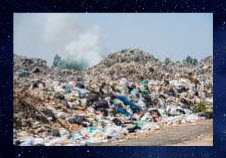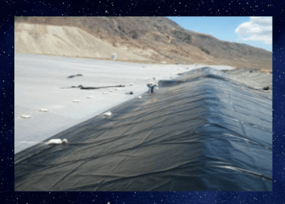High-Density Polyethylene (HDPE) geomembranes are versatile and durable materials widely used in various industries for containment and protection purposes. This comprehensive blog delves into the diverse applications of HDPE geomembrane, exploring each application's significance, benefits, and environmental impact.
1. Landfills and Leachate Ponds
Landfills utilize HDPE geomembranes as liners to prevent leachate, which is a toxic liquid formed by rainwater percolating through waste, from contaminating the surrounding soil and groundwater. Leachate ponds, lined with HDPE geomembranes, collect and contain the leachate for proper treatment and disposal, ensuring environmental protection.
Example of an actual landfill:

The Fresh Kills Landfill in Staten Island, New York, is a well-known example of a landfill that utilizes an HDPE liner.
This former landfill, which operated from 1948 to 2001, was once the largest landfill in the world by volume. During its closure and conversion into a park, a complex capping system was implemented, including a 60-mil HDPE geomembrane liner as a key component. This liner plays a crucial role in preventing leachate (contaminated liquid) from migrating into the surrounding environment and protecting the underlying groundwater.
It's important to note that this is just one example, and numerous landfills worldwide incorporate HDPE liners in their construction for environmental protection and compliance with regulations.
2. Mining and Tailings Management
In the mining industry, HDPE geomembranes as well as XR-5 Geomembranes serve as liners for tailings dams and containment ponds, preventing the release of hazardous chemicals and pollutants into the environment. These liners ensure the safe containment and management of mining by-products, reducing the risk of soil and water contamination.
3. Agricultural Water Storage
HDPE geomembranes are used in agricultural water storage systems, such as reservoirs, ponds, and irrigation canals, to prevent water seepage and optimize water management practices. These liners help conserve water resources, improve irrigation efficiency, and support sustainable agricultural practices.
An Example of an Agricultural Water Storage System using a HDPE Geomembrane
The Elephant Butte Irrigation District in New Mexico utilizes a large reservoir lined with HDPE geomembrane to store water for irrigation purposes.
4. Aquaculture and Fish Farming
In aquaculture facilities and fish farms, HDPE geomembranes are employed in pond liners to create a waterproof barrier, preventing water loss and seepage. These liners ensure optimal water retention, maintain water quality, and support the growth and health of aquatic organisms.
5. Environmental Remediation
HDPE geomembranes play a vital role in environmental remediation projects, such as hazardous waste containment sites and contaminated landfills. These liners isolate and contain pollutants, preventing their migration into the surrounding environment and mitigating the risk of environmental contamination.
6. Industrial Chemical Storage
Industries utilize HDPE geomembranes in chemical storage facilities and secondary containment systems to prevent leaks and spills of hazardous chemicals. These liners provide an impermeable barrier, safeguarding the surrounding environment from potential chemical pollution and ensuring compliance with regulatory standards.
What is Industrial Chemical Storage?
Industrial chemical storage refers to the containment and safe storage of hazardous chemicals and substances in industrial facilities, such as manufacturing plants, chemical processing plants, and storage warehouses. It is necessary when handling chemicals that pose risks to human health, safety, and the environment, such as corrosive acids, flammable liquids, and toxic substances. HDPE geomembranes are commonly used at these sites as liners for chemical storage tanks, containment ponds, and secondary containment systems. HDPE geomembranes provide a durable and impermeable barrier that prevents the leakage or seepage of hazardous chemicals into the surrounding soil and groundwater. They offer excellent chemical resistance, high tensile strength, and puncture resistance, ensuring the safe containment of chemicals and protecting the environment from potential contamination
7. Floating Covers and Evaporation Reduction
HDPE geomembranes are used in floating covers and evaporation reduction systems for reservoirs, ponds, and wastewater treatment lagoons. These covers reduce water loss through evaporation, conserve water resources, and minimize the need for additional water supply, particularly in arid regions.
8. Stormwater Management
In stormwater management systems, HDPE geomembranes are utilized in retention ponds, detention basins, and stormwater storage tanks to prevent runoff and soil erosion. These liners capture and contain stormwater runoff, allowing for controlled release and reducing the risk of flooding and water pollution.
In conclusion, HDPE geomembranes play a critical role in various applications, ranging from landfill liners and mining containment to agricultural water storage and environmental remediation. These versatile liners provide durable and reliable containment solutions, protecting infrastructure and the environment while supporting sustainable development practices across industries.



